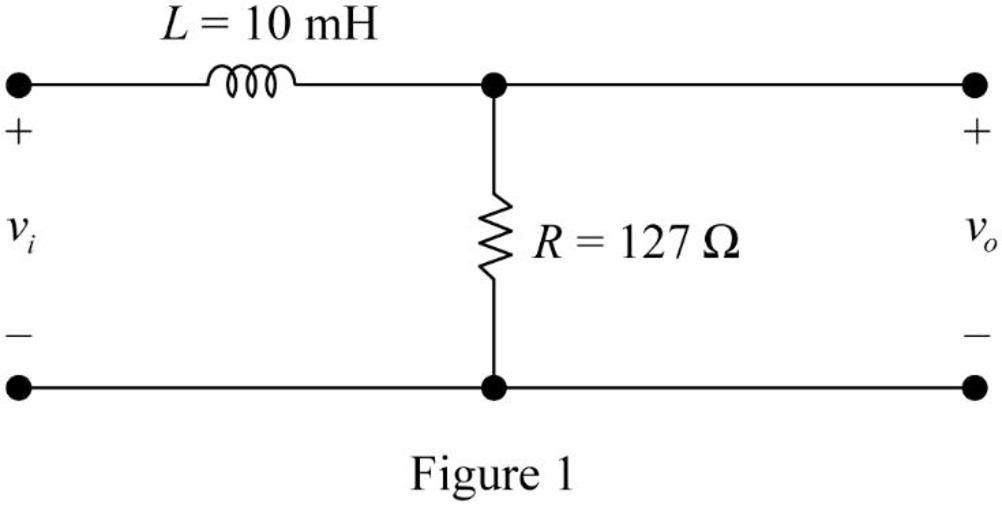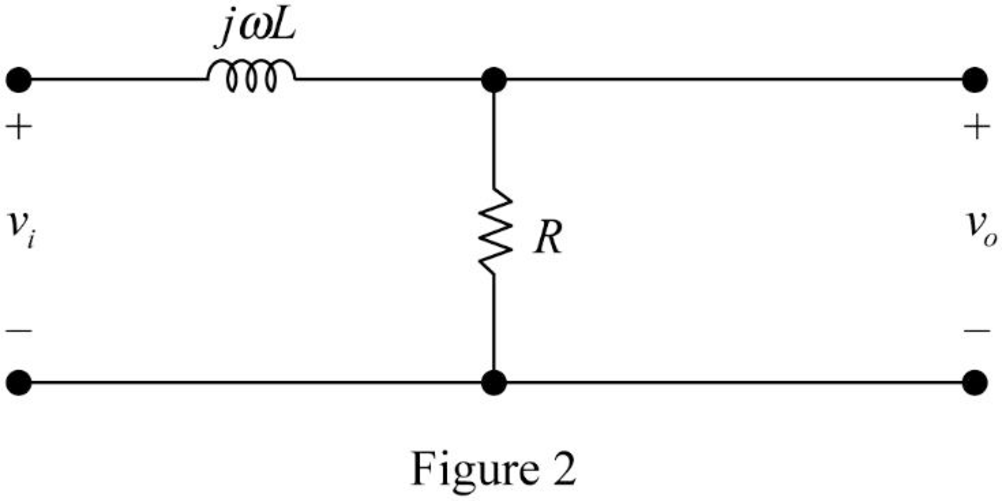
Concept explainers
(a)
Find the value of the cutoff frequency in hertz for the RL filter shown in given figure.
(a)
Answer to Problem 1P
The value of the cutoff frequency
Explanation of Solution
Given data:
Refer to given figure in the textbook.
Formula used:
Write the expression to calculate the angular cutoff frequency.
Here,
Write the expression to calculate the cutoff frequency of the RL low-pass filter.
Here,
Calculation:
The given filter circuit is drawn as Figure 1.

Substitute
Simplify the above equation to find
Substitute
Rearrange the above equation to find
Conclusion:
Thus, the value of the cutoff frequency
(b)
Find the value of the transfer function
(b)
Answer to Problem 1P
The value of the transfer function
Explanation of Solution
Formula used:
Write the expression to calculate the impedance of the passive elements resistor and inductor.
Calculation:
The impedance circuit of the Figure 1 is drawn as Figure 2 using the equations (3) and (4).

Apply voltage division rule on Figure 2 to find
Rearrange the above equation to find
Substitute the equation (2) in above equation to find
Write the expression to calculate the transfer function of the circuit in Figure 2.
Substitute
Substitute
Substitute
Substitute
Substitute
Substitute
Substitute
Substitute
Conclusion:
Thus, the value of the transfer function
(c)
Find the steady state expression for the output voltage
(c)
Answer to Problem 1P
The steady state expression for the output voltage
Explanation of Solution
Given data:
The input voltage is,
Calculation:
From part (b),
Rearrange the above equation to find
Substitute
Substitute
Substitute
Simplify the above equation to find
Substitute
Substitute
Simplify the above equation to find
Substitute
Substitute
Simplify the above equation to find
Conclusion:
Thus, the steady state expression for the output voltage
Want to see more full solutions like this?
Chapter 14 Solutions
Electric Circuits Plus Mastering Engineering with Pearson eText 2.0 - Access Card Package (11th Edition) (What's New in Engineering)
- Describe functionalities of the “Battery Management System” and explain how the cell balancing is performed by the BMS.arrow_forwardPlease answer handwritten, do not use chat gbtarrow_forward1) The parameters for circuit in Figure 1 are ẞ₁ = 120, B2=80, VBE1 (On) = VBE2 (on) = 0.7 V and VA1 = VA2 = ∞0. a) Find the collector current in each transistor. b) Find the small signal voltage gain Av = Vo/Vs. c) Find the I/O resistance. Rib 5V. Figure 1 Q₁ 0.5 k Vcc=9V Q2 R ww 50 Ωarrow_forward
- 3) In the circuit in Figure 3, the Transistor parameters are VTN = 0.8 V and Kn = 0.5 mA/V2. Calculate ID, VGS, and VDS. VDD = 10 V Κ = 32 ΚΩ Κρ=4ΚΩ R2 = 18 ΚΩ Rs = 2k Figure 3arrow_forward2) Consider the circuit in Figure 2, The transistor parameters are VTP = -0.8 V and Kp = 0.5 mA/V2. Determine ID, VSG and VSD.arrow_forwardFor the circuit shown, let V₁ = 12 V, Is1 = 2A, Is2 = 4A, R₁ = 2, R2 = 4, and R3 = 6. Determine the current Io using Mesh method as follows: 1. Choose all meshes that must be included, if any, to construct the supermesh. 11, 13 O 11, 12 O 12, 13, 11 12, 13 O none of the above 2. Consider mesh (loop) iz, write the corresponding expression in terms of mesh currents i₁, 12, 13 as of the form (R11 · i₁ + R₁2 · 2 + R₁3-13 = V₁), then enter the corresponding values: R11 R12 R13 Ω Ω Ω V V₁₂ 3. Solve the above equation to determine then lo : 10 = Ist A R₁ ww ww R₂ + V₁ 1, R3 The relative tolerance for this problem is 7%. ww IS2arrow_forward
- Enter the matrix values (numerical) to solve for mesh-currents i₁, iz and 13, for the circuit shown, using Mesh method. In the matrix, row 1, row 2, and row 3 correspond to i₁, 12 and 13, current expressions, respectively. Let Vs=15, R₁ =50, R₂-32, R3-8, R4-17, R5-29, and R=41. [R11 R12 R13 The matrix values are shown here: R21 R22 R23 = V₂ R31 R32 R33 [V3] The relative tolerance for this problem is 5%. R1 Loop i₁ R11 + Vs Ω R12 Ω R13 Ω V V₁= Loop 12 R21 Ω R22 Ω R23 Ω V V₂ Loop 13 Ω R31 R32 Ω R33 Ω V3= V R2 R4 R3 R5 R6arrow_forwardFor circuit shown, use Mesh method to find the voltage Vo as follows. Enter, in the matrix format, as below, the loop currents, where row 1, and row 2, correspond to i₁, and i2 loop current expressions, respectively. Let Vs1-5, Vs2-15, R₁=5, R₂=2, and R3=8. The matrix values are shown here: [R11 R12 21 R21 R22 Rx - M - M iz = The relative tolerance for this problem is 5%. Vst (+- R1 ww Loop i₁ R115 G12 V₁ = Loop 12 R21 R22 V₂= Ω C C Ω V Ω 02 C V R₂ ww VS2 + Ry ww + Vo Use Cramer's rule (matrix), substitution, or any other method to calculate the voltages:arrow_forward= = For the circuit shown, let V, 15 V, I, 4A, R₁ =5, R₂ 10, R3 10, and R4 5. Determine the output voltage Vo as follows All resistor values are in ohms. 1. Identify the supermesh and write its corresponding Mesh equation. Provide your expression in terms of the shown mesh current i₁, and 12 of the form (R11 · 11+ R12 · 12 = V₁), then enter the corresponding values: R11 Ω R12 V₁= V Ω 2. Use the above equation, and supermesh inner expression to calculate i₂: i₂- Find Vo V₁ = A V R₁ www M R3 ww V R4 V₁ 0 IS R₁ The relative tolerance for this problem is 7 %. 0arrow_forward
 Introductory Circuit Analysis (13th Edition)Electrical EngineeringISBN:9780133923605Author:Robert L. BoylestadPublisher:PEARSON
Introductory Circuit Analysis (13th Edition)Electrical EngineeringISBN:9780133923605Author:Robert L. BoylestadPublisher:PEARSON Delmar's Standard Textbook Of ElectricityElectrical EngineeringISBN:9781337900348Author:Stephen L. HermanPublisher:Cengage Learning
Delmar's Standard Textbook Of ElectricityElectrical EngineeringISBN:9781337900348Author:Stephen L. HermanPublisher:Cengage Learning Programmable Logic ControllersElectrical EngineeringISBN:9780073373843Author:Frank D. PetruzellaPublisher:McGraw-Hill Education
Programmable Logic ControllersElectrical EngineeringISBN:9780073373843Author:Frank D. PetruzellaPublisher:McGraw-Hill Education Fundamentals of Electric CircuitsElectrical EngineeringISBN:9780078028229Author:Charles K Alexander, Matthew SadikuPublisher:McGraw-Hill Education
Fundamentals of Electric CircuitsElectrical EngineeringISBN:9780078028229Author:Charles K Alexander, Matthew SadikuPublisher:McGraw-Hill Education Electric Circuits. (11th Edition)Electrical EngineeringISBN:9780134746968Author:James W. Nilsson, Susan RiedelPublisher:PEARSON
Electric Circuits. (11th Edition)Electrical EngineeringISBN:9780134746968Author:James W. Nilsson, Susan RiedelPublisher:PEARSON Engineering ElectromagneticsElectrical EngineeringISBN:9780078028151Author:Hayt, William H. (william Hart), Jr, BUCK, John A.Publisher:Mcgraw-hill Education,
Engineering ElectromagneticsElectrical EngineeringISBN:9780078028151Author:Hayt, William H. (william Hart), Jr, BUCK, John A.Publisher:Mcgraw-hill Education,





